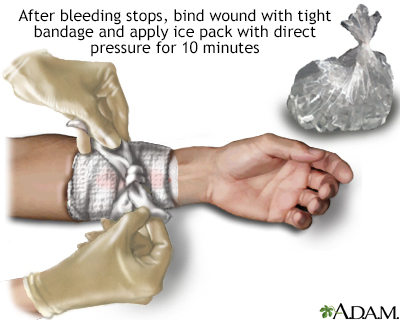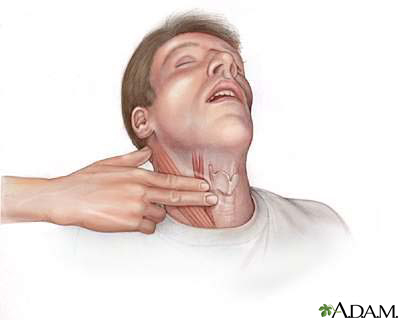Definition
Getting medical help right away for someone who is having a medical emergency can save their life. This article describes the warning signs of a medical emergency and how to be prepared.
Alternative Names
Medical emergencies - how to recognize them
Information
According to the American College of Emergency Physicians, the following are warning signs of a medical emergency:
- Bleeding that will not stop
- Breathing problems (difficulty breathing, shortness of breath)
- Change in mental status (such as unusual behavior, confusion, difficulty arousing)
- Chest pain
- Choking
- Coughing up or vomiting blood
- Fainting or loss of consciousness
- Feeling of committing suicide or murder
- Head or spine injury
- Severe or persistent vomiting
- Sudden injury due to a motor vehicle accident, burns or smoke inhalation, near drowning, deep or large wound, or other injuries
- Sudden, severe pain anywhere in the body
- Sudden dizziness, weakness, or change in vision
- Swallowing a poisonous substance
- Severe abdominal pain or pressure
BE PREPARED:
- Determine the location and quickest route to the nearest emergency department before an emergency happens.
- Keep emergency phone numbers posted in your home where you can easily access them. Also enter the numbers into your cell phone. Everyone in your household, including children, should know when and how to call these numbers. These numbers include: fire department, police department, poison control center, ambulance center, your doctors' phone numbers, contact numbers of neighbors or nearby friends or relatives, and work phone numbers.
- Know at which hospital(s) your doctor practices and, if practical, go there in an emergency.
- Wear a medical identification tag if you have a chronic condition or look for one on a person who has any of the symptoms mentioned.
- Get a personal emergency response system if you're an older adult, especially if you live alone.
If you or someone you know is thinking about hurting yourself or others, call or text 988 or chat 988lifeline.org. You can also call 1-800-273-8255 (1-800-273-TALK). The 988 Suicide and Crisis Lifeline provides free and confidential support 24/7, anytime day or night.
You can also call 911 or the local emergency number or go to the hospital emergency room. DO NOT delay.
If someone you know has attempted suicide, call 911 or the local emergency number right away. DO NOT leave the person alone, even after you have called for help.
Always take suicide attempts and threats seriously.
WHAT TO DO IF SOMEONE NEEDS HELP:
- Stay calm, and call 911 or your local emergency number.
- Start CPR (cardiopulmonary resuscitation) or rescue breathing, if necessary and if you know the proper technique.
- Place a semiconscious or unconscious person in the recovery position until the ambulance arrives. DO NOT move the person, however, if there has been or may have been a neck injury.
Upon arriving at an emergency room, the person will be evaluated right away. Life- or limb-threatening conditions will be treated first. People with conditions that are not life- or limb-threatening may have to wait.
CALL 911 OR YOUR LOCAL EMERGENCY NUMBER IF:
- The person's condition is life threatening (for example, the person is having a heart attack or severe allergic reaction)
- The person's condition could become life threatening on the way to the hospital
- Moving the person could cause further injury (for example, in case of a neck injury or motor vehicle accident)
- The person needs the skills or equipment of paramedics
- Traffic conditions or distance might cause a delay in getting the person to the hospital
References
American College of Emergency Physicians website. Know when to go. www.emergencyphysicians.org/article/know-when-to-go/know-when-to-go-overview. Accessed April 22, 2021.
Blackwell TH. Emergency medical services: overview and ground transport. In: Walls RM, Hockberger RS, Gausche-Hill M, eds. Rosen's Emergency Medicine: Concepts and Clinical Practice. 9th ed. Philadelphia, PA: Elsevier; 2018:chap 190.




